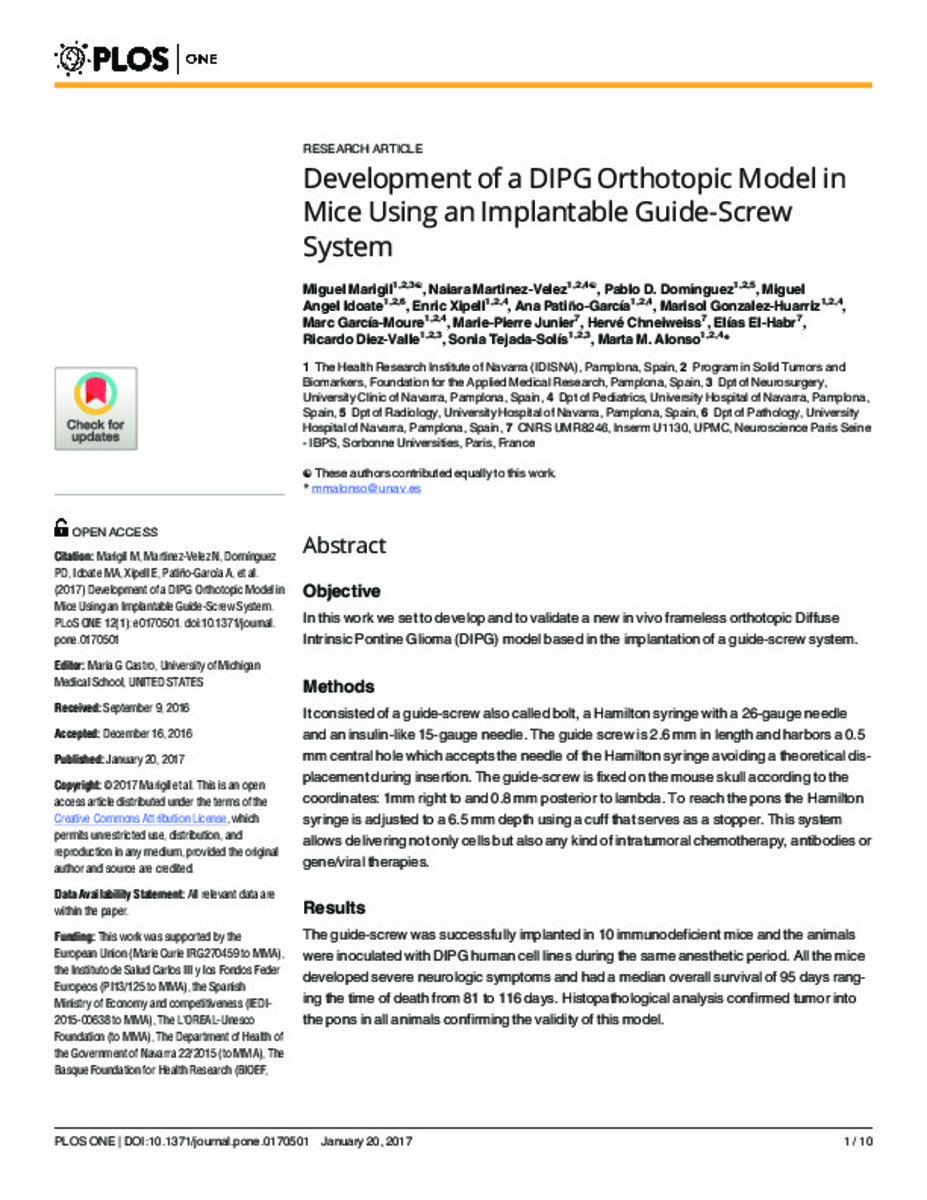Full metadata record
| DC Field | Value | Language |
|---|---|---|
| dc.creator | Marigil, M. (Miguel) | - |
| dc.creator | Martinez-Velez, N. (Naiara) | - |
| dc.creator | Domínguez-Echávarri, P.D. (Pablo Daniel) | - |
| dc.creator | Idoate, M.A. (Miguel Ángel) | - |
| dc.creator | Xipell, E. (Enric) | - |
| dc.creator | Patiño-García, A. (Ana) | - |
| dc.creator | Gonzalez-Huarriz, M. (Marisol) | - |
| dc.creator | Garcia-Maure, M. (Marc) | - |
| dc.creator | Junier, M.P. (Marie Pierre) | - |
| dc.creator | Chneiweiss, H. (Hervé) | - |
| dc.creator | El-Habr, E. (Elías) | - |
| dc.creator | Diez-Valle, R. (Ricardo) | - |
| dc.creator | Tejada-Solis, S. (Sonia) | - |
| dc.creator | Alonso-Roldán, M.M. (Marta María) | - |
| dc.date.accessioned | 2017-04-05T10:04:13Z | - |
| dc.date.available | 2017-04-05T10:04:13Z | - |
| dc.date.issued | 2017 | - |
| dc.identifier.citation | Marigil M., Martinez-Velez N, Domínguez P.D., Idoate M.A., Xipell E., Patiño A, et al. Development of a DIPG Orthotopic Model in Mice Using an Implantable Guide-Screw System. PLoS ONE 2017 Jan 20;12(1):e0170501. | es_ES |
| dc.identifier.issn | 1932-6203 | - |
| dc.identifier.uri | https://hdl.handle.net/10171/43225 | - |
| dc.description.abstract | Objective In this work we set to develop and to validate a new in vivo frameless orthotopic Diffuse Intrinsic Pontine Glioma (DIPG) model based in the implantation of a guide-screw system. Methods It consisted of a guide-screw also called bolt, a Hamilton syringe with a 26-gauge needle and an insulin-like 15-gauge needle. The guide screw is 2.6 mm in length and harbors a 0.5 mm central hole which accepts the needle of the Hamilton syringe avoiding a theoretical displacement during insertion. The guide-screw is fixed on the mouse skull according to the coordinates: 1mm right to and 0.8 mm posterior to lambda. To reach the pons the Hamilton syringe is adjusted to a 6.5 mm depth using a cuff that serves as a stopper. This system allows delivering not only cells but also any kind of intratumoral chemotherapy, antibodies or gene/viral therapies. Results The guide-screw was successfully implanted in 10 immunodeficient mice and the animals were inoculated with DIPG human cell lines during the same anesthetic period. All the mice developed severe neurologic symptoms and had a median overall survival of 95 days ranging the time of death from 81 to 116 days. Histopathological analysis confirmed tumor into the pons in all animals confirming the validity of this model. Conclusion Here we presented a reproducible and frameless DIPG model that allows for rapid evaluation of tumorigenicity and efficacy of chemotherapeutic or gene therapy products delivered intratumorally to the pons. | es_ES |
| dc.language.iso | eng | es_ES |
| dc.publisher | Public Library of Science - Green Policies in RoMEO | es_ES |
| dc.relation | info:eu-repo/grantAgreement/MINECO/Ayudas para incentivar la incorporación estable de doctores (2015)/IEDI- 2015-00638/ES/IEDI-2015-00638 | - |
| dc.rights | info:eu-repo/semantics/openAccess | es_ES |
| dc.subject | Materias Investigacion::Ciencias de la Salud::Neurología | es_ES |
| dc.title | Development of a DIPG Orthotopic Model in Mice Using an Implantable Guide-Screw System | es_ES |
| dc.type | info:eu-repo/semantics/article | es_ES |
| dc.identifier.doi | http://dx.doi.org/10.1371/journal.pone.0170501 | es_ES |
Files in This Item:
Statistics and impact
Items in Dadun are protected by copyright, with all rights reserved, unless otherwise indicated.






